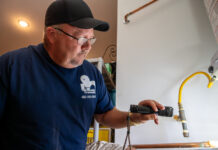Whether you recently moved into a new home or you’re looking for inexpensive updates to spruce-up your existing residence, consider experimenting with color.
Paint is the number one do-it-yourself (DIY) project because it’s easy, affordable and instantly refreshes the look of a room. The painting project has become even easier with advances in paint technology and application to save every DIYer time and money.
“Painting can refresh or change the look and feel of an entire room with a little planning and know-how and for less than $100,” says remodeling expert and DIY Network host Amy Matthews. “However, not everyone knows where to start or how to achieve the look they desire. That’s why preparation is so important.”
Even the most novice DIYer can complete a painting project with great results. This checklist provides everything you need for a perfect paint job, the first time, regardless of skill or experience:
• Painter’s tape. Tape with UV resistance will usually improve results if you are planning on using multiple coats and works well for both smooth and textured surfaces. 3M has recently introduced a new ScotchBlue Painter’s Tape with a paint line protector. The tape helps avoid seepage and ensures clean, crisp lines to give DIYers an edge.
• No-VOC paint. In addition to picking out the right color, select paint with zero-VOCs (volatile organic compounds), so you can breathe easier and maintain a healthy indoor air quality. Lowe’s is the only national home improvement store to carry zero VOC paint available in any color.
• Paint roller with extension pole, brushes, roller tray and roller covers. For the best finish, use quality brushes. You’ll need two brushes for every project – a small one for painting trim or detailed areas and a large one for covering surfaces quickly. Since most interior paints are water-based, choose a nylon or polyester (synthetic) brush.
• Putty knife or 5-in-1 tool, spackle and sandpaper
• Gloves, rags and drop cloths
• A level and tape measure if you are planning on different decorative techniques
Once you have your supplies, it’s time to prepare the surface you will be painting:
• Fill cracks and holes with spackle. Sand after it has dried to make smooth.
• Dust and clean walls with a towel or vacuum cleaner.
• Apply painter’s tape. Pull the tape off the roll a few feet at a time and avoid stretching tape. Secure the tape by pressing down with a putty knife or 5-in-1 tool. Use a credit card if you don’t have one of these.
• If the surface is highly textured, seal the edge of the tape with the existing base color of the wall, as it will prevent paint from seeping under the tape.
Now you are ready to paint. Here are a few tips to keep in mind:
• When using a roller, paint in 3-foot by 3-foot sections. Paint in long strokes using a zigzag pattern for a more even coating. Go back over areas if they look like they aren’t fully covered.
• Always start in the highest areas, so drips can be smoothed as you go.
• Once paint has dried, remove painter’s tape at a 45-degree angle at a moderate speed, pulling the tape back on itself. If the adhesive is sticking to the surface, try a 90-degree angle.
Once the paint has dried and the tape has been removed, assess your work. If you’re satisfied, you can move on to more challenging paint projects with creative applications, such as faux painting or stripes.
File photo
















![Shred-A-Thon to take place tomorrow An image of shredded paper. [Pixabay]](https://www.inmaricopa.com/wp-content/uploads/2024/03/shredded-paper-168650_1280-100x70.jpg)
